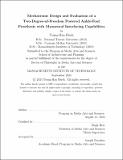Mechatronic Design and Evaluation of a Two-Degree-of-Freedom Powered Ankle-Foot Prosthesis with Myoneural Interfacing Capabilities
Author(s)
Hsieh, Tsung-Han
DownloadThesis PDF (106.9Mb)
Advisor
Herr, Hugh
Terms of use
Metadata
Show full item recordAbstract
Recent advancements in neural interfaces and sensing technologies have opened new possibilities for enhanced prosthesis control. The agonist-antagonist myoneural interface (AMI) connects residual muscle pairs to emulate natural dynamics, while electronic osseointegrated prostheses for the rehabilitation of amputees (eOPRA) allow direct measurement of neural signals through implants. Additionally, magnetomicrometry enables precise, real-time measurement of muscle length. These innovations motivate the development of more sophisticated prosthetic designs, including two degrees of freedom (2DoF) ankle systems.
This Ph.D. thesis advanced bionic limb technology through three primary aims. First, a comprehensive characterization study of human-scale actuators was conducted, including brushless motors of different sizes. Using a custom-built dynamometer, the performance of these actuators was evaluated across their full operating range. Building upon this foundation, an innovative bionic ankle-foot prosthesis with enhanced capabilities was designed and fabricated. This advanced prosthetic system achieved biological fidelity in terms of range of motion, torque output, and angular velocity, thus enabling more natural and adaptable gait patterns. To validate the efficacy of the system, a subject with AMI constructs was fitted with the prosthesis and underwent a series of locomotion tasks, including level-ground ambulation and obstacle traversal.
This work pushed the boundaries of bionic limb function and advanced the restoration of natural locomotion after lower limb amputation, providing valuable insights into the potential of combining advanced prosthetic design with neural interfacing techniques.
Date issued
2024-09Department
Program in Media Arts and Sciences (Massachusetts Institute of Technology)Publisher
Massachusetts Institute of Technology